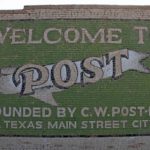Our October issue featured a dozen magnificent stops, and we continue on in November with another must-see set.
27. Catch The Spirit of Colonel Charles Goodnight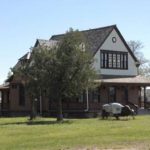
Talk about titles! Because this legendary figure of the American West just happened to have established the 1st permanent cattle-raising operation in the Texas Panhandle in 1876, and because that JA Ranch is still the oldest ranch and the oldest enterprise in the Panhandle, I guess it would be fitting for Charles Goodnight to own the title, “Father of the Panhandle.” And his wife, Mary Ann, was certainly notable, too! With her husband’s assistance, she saved a remnant of the southern herd of bison. Today, you can view the descendants of these animals at the Caprock Canyon State Park. Thankfully, a group of passionate folks have just recently restored his original home, the Colonel Charles Goodnight Historical Center on HWY 287 in Goodnight (between Clarendon & Claude). This house is the most significant artifact related to Charles Goodnight, who embodies the individuality, bravery, and fairness that is the legacy of Texas. Charles and Mary Ann are both buried in Goodnight in a little cemetery overlooking the vast plains where he most likely rounded up many a cow. Somewhat of a spiritual experience…if you close your eyes, you just “might” catch an echo from the past.
28. Roam To Morton’s Annual Buffalo Soldier Encampment Celebration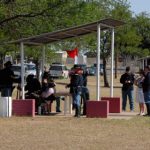
Every June, herds, I mean hoards, of people gather at the Cochran County Park outside of Morton to celebrate and relive the historic trek of the Buffalo Soldiers and their buffalo hunter companions, commanded by Capt. Nicholas M. Nolan and Lt. Charles L. Cooper. The 1877 Lost Troop Expedition literally marched across the very site that is now the Cochran County Park. The re-enactment is brought by the Texas Parks and Wildlife Department’s Buffalo Soldier Living History Program, the U.S. 10th Cavalry Fort Concho Buffalo Soldiers, the U.S. 2nd Cavalry Camel Corps, the Cochran County Historical Commission, and Texas’ Last Frontier Museum. The historic yet fun day includes games, parades, vintage baseball, and a tour to the Morton Cemetery where markers commemorate four Buffalo Soldiers who perished in that 1877 expedition.The Buffalo Soldiers, the first African-Americans to serve in the U.S. military during a time of peace, were given the name by the Cheyenne Indians because of their strength and courage in battle; in addition, their dark, curly hair resembled the mane of the buffalo. Their dedication helped build the American West, and thanks to Cochran County, their service is given due honor.
29. Rest A While At The Silver Falls Park In Crosbyton
Bragging about a rest stop, you say? Well, the Silver Falls Park on Highway 82 east of Crosbyton is no ordinary stop-your-car-check-the-tires kind of place. Silver Falls Park is the largest and one of the finest roadside parks in Texas. In 1872 and 1874 Ranald S. McKenzie camped near the falls during his campaigns against the Indians, and in 1935 the National Youth Association, part of President Roosevelt’s Work Project Administration, built the park’s stone facilities. Since the 1800s travelers have found Silver Falls a scenic and welcome respite from their long journeys. Silver Falls Park had a recent makeover with new restrooms, a visitors information center, and extra-shaded picnic tables. So get your motor running in that direction, as this is a great place for those cooped-up kids to enjoy hiking, backpacking and picnicking.
30. Dedicate a Day at the POW Deaf Smith/Castro County War Camp Site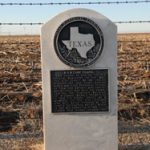
About 3 ½ miles south of Hereford stands an amazing little chapel that serves as a testimony that, even during war times, love prevails. During World War II, the Hereford POW camp covered about 800 acres of open Panhandle land in Castro and Deaf Smith counties. The estimated 7,000 Italian POWs were held at the site from February 1943 until June 1946. Toward the end of the war several of the prisoners who were fine artisans and craftsmen received permission to design and build the chapel to provide a marker for the burial site of their five fellow soldiers. The chapel stood for the next 40 years as a reminder of the significance of the site, but over time its condition deteriorated, until in 1988 those former POWs contributed money to begin its restoration. Thanks to local volunteer efforts, the chapel has survived for more than 66 years as a historic monument that binds the people who met through opposite sides of the war, but have surpassed those war time wounds with respect and friendship…all right here in the Texas Panhandle.
31. Drive to Dickens Spring Park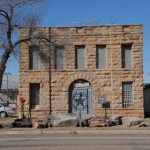
For Dickens’s sake, another rest stop! The hard-working folks in the Texas Plains Trail Region know that time for the 3 R’s, relaxation, refreshment, and reflection, have to be etched in to their lives, so it just makes sense to have several great places to just stop and play. Right on the east side of Dickens, “the Unofficial Wild Boar Hunting Capital of Texas” is Dickens Spring Park. It has attracted nomadic travelers for many centuries, and now modern picnic sites makes visitors want to stop, relax, hike and enjoy the picturesque views. The park’s history began in 1891, and the community continues to make sure that it is maintained for travelers and local activities. And since you are already there, take some time to hang around and explore the historic Dickens County Courthouse. Oh, and check out the humongous spur in, where else? Spur.
Let’s Go to Post! That’s what folks said when cereal king C.W. Post chose Garza County to start a utopian community. The alluring rolling prairies drew cowboys, farmers, and merchants to the little town at the edge of the majestic Llano Estacado escarpment. Post bloomed with support from its founder and later boomed with oil discoveries. Garza County Museum tells the area history, and the OS Museum houses art treasures. Shoppers flock to Post, and Trade Day is each first Saturday downtown. The Ragtime Gospel Theater produces biblical stage shows. Other attractions are bass fishing, rodeos and scenic drives. The old slogan has a new twist: Let’s go back to Post!
33. Get Your MOO on at Miami’s Cow Calling Festival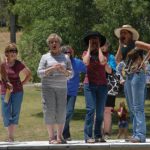
If this celebration doesn’t scream Texas, I don’t know what does! No bull, every June hundreds of folks from all over drive to Miami (Texas, that is) to scream and yell at the top of their lungs all in the name of vying for the National Cow Calling Championship. This fun event has been going on since 1949 when “Old Tack,” otherwise known as humorist, columnist, publisher, and conservationist Gene Howe of Amarillo, made the wise suggestion. In between all of the activities and the steak cook-off, you might mosey on over and check out the newly restored Roberts County Courthouse.
34. Every March, Shamrock is filled to its Irish gills with more green than you’ve ever seen! No doubt, you’ll be feeling like a lucky charm in this precious Route 66 community. With the name of Shamrock, it’s a no-
brainer that the day is overflowing with everything Irish – from kissing a Blarney Stone to a Donegal Beard Contest. Stop by the historical U-Drop Inn, which was used as the inspiration for Ramone’s body shop in the movie “Cars.” After this two-day event, your Irish eyes will surely be smiling.34. Shimmy to Shamrock for Irish Day
35. Wind Your Way to Yoakum County For Wine and Watermelon
Now really, is there anything better than that combination? Yoakum County offers up a whole festival devoted to the icy cold watermelons! Tons of them arrive in Plains for the annual Watermelon Festival over Labor Day weekend. Games, food, and fun are also part of the mix, and you can stroll through vendors on the courthouse grounds and the nearby museum. And if that’s not enough to quench your thirst, then perhaps a refreshing glass of wine from the vast vineyards that are found in the county might do the trick. (Ask for directions to the Newsom Winery). A second county museum can be found just down the road in Denver City. Here the historic oil patch is bustling and you can golf, swim or picnic at the Yoakum County Park and Golf Course surrounded by oil wells and sand hills. Cheers!
36. Hunt Up Some Wildlife in Stratford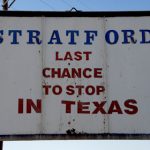
With more wild birds in a natural habitat than anywhere else in Texas, Stratford is certainly a hunter’s haven. Hunters can grab their gear and take advantage of a reasonably priced adventure that won’t break the bank in the “Pheasant Capital” of Texas. Located in the western tip of the Texas panhandle, Stratford conducts its annual hunt the first weekend of the season in December which includes the Lions Club annual breakfast. They’ll even provide guides. And Stratford is also known for its Elks. (Not the hunting kind.) Yes, the Stratford Elks have a long-standing reputation in sports with several state championships under their belt. With its restored downtown area, cute shops, and eateries, there’s a lot more to hunt down in Stratford. Aim North…and a hunting you will go!
37. Trace the Steps of Quanah Parker through “his” Town, Quanah
In 1890, the Comanche chief – son of white captive Cynthia Ann Parker and warrior Peta Nocona – blessed his namesake city. See his image and the blessing on a monument on the downtown square. Tour the old headquarters of the Quanah, Acme & Pacific Railroad, now a museum, open 10 a.m. to 3 p.m. daily except Sunday. See Quanah 24-7 in colorful regalia in the mural in the post office. East of Quanah, if you don’t stop and shop in Chillicothe, at least slow down and notice the kiosk. At Goodlett, west of Quanah, see the old cotton gin, and drink a long-necked root beer at the RV Park.
38. Follow the Quanah Parker Trail of Arrows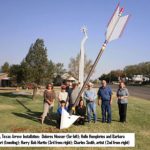
The Quanah Parker Trail – www.quanahparkertrail.com – takes travelers in all directions across the Texas Plains Trail Region, from Quanah’s namesake town of Quanah to points beyond to the south, north and west, almost to New Mexico. More than a route, the trail is a collection of places on the Texas Plains with proven ties to the famous Comanche chief or to his tribe and their allies. Travelers are invited to connect the dots in any order to make their own trails across Quanah country. Many places on the trail are marked with 22-foot-long steel arrows painted in Comanche colors, the work of sculptor Charles Smith. Some of the arrows have granite markers with legends that explain their significance; some arrows are as yet unmarked. Most places on the Quanah Parker Trail have museums with displays that document and illustrate the presence of Indian tribes in the Plains from centuries ago to Quanah’s era, the latter 1800s into the 20th century. Some of the arrows have caches to be discovered by geo-cache enthusiasts. Some are easy to find; others are off the beaten track.
The trail website offers maps and information to help anyone plan a trip to the Texas Plains Trail Region. The welcome page offers this advice and commentary:
Make your own trail.
Drive it if you can. Surf it if you can’t.
Something to keep in mind:
The story of Quanah Parker, son of Comanche warrior Peta Nocona and White captive-turned-Comanche Cynthia Ann Parker, stretches far beyond this site in geographical scope and in historical and cultural significance.
More meaningful than the miles Quanah traveled is the distance he covered between disparate cultures and the transition he made between different ages in the history of the American West.
For better or worse, Quanah led his people into the 20th Century.










